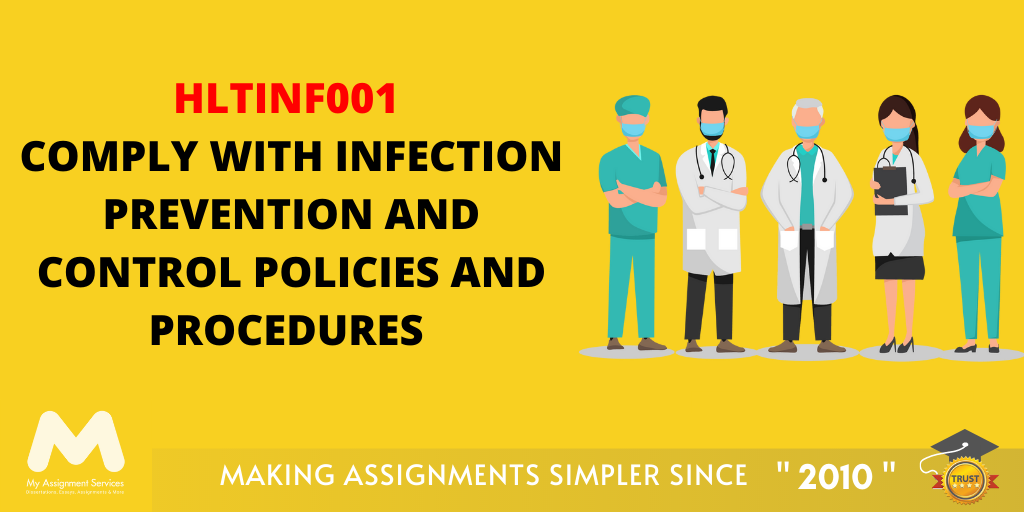
The unit HLTINF001 aims to teach students the knowledge and skills required to implement and follow infection control/prevention measures - implementing protocols for controlling transmission of infectious diseases and response procedures for infection risks. The key learnings in this unit are useful for people employed in the healthcare and direct client response sectors.
As the recent circumstances have been, the world is dealing with the Coronavirus, global leaders are focusing on controlling and preventing the spread of this lethal virus. The basics of personal hygiene that we took for granted and often forgotten are now the very thing protecting us. We all witnessed instructions to wash our hands broadcast on TV and microphones in public places.
"To slow down and prevent the transmission of the Covid-19 virus, we all should be well informed about the virus's spread. Staying a metre away from one another, properly wearing a fitted face mask, using a sanitiser (alcohol-based) frequently or washing your hands is useful in preventing the spread of the virus." - Advisory Released by World Health Organisation for prevention and control of Coronavirus.
Many infections are transmitted through airborne droplets that contact the person's eye, mouth, or nose. Hence, the number of cases of infection is rapidly increasing by the day. In this unit, you will learn the prevention and control measures necessary for the control/prevention of infections like Covid-19. Read forth to get HLTINF001 assessment answers.
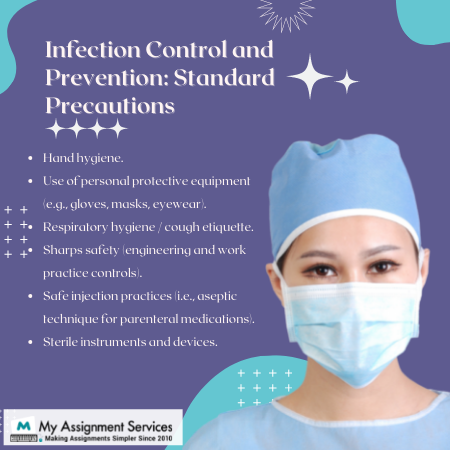
What Is a Nosocomial Infection, And Why Is Its Knowledge Significant in Nursing Practice?
Healthcare-oriented or acquired infections in the hospitals are called Nosocomial infections. These are the forms of diseases that can be acquired in hospitals through infectious carriers and bad hygiene on the premises. An infection is considered nosocomial if the patient doesn't show any symptoms during admission but develops such symptoms after at least 48 hours of admission to the hospital. The result may be sepsis or even death.
Nosocomial infections or NI are often caused by drug-resistant carriers that might be acquired during invasive procedures for treatment. Improper or excessive use of antibiotics and not abiding by the infection management and prevention protocols. Many NI can be prevented by following the guidelines or advisory issued by national health and infection prevention institutions, like AIHW (Australian Institute of Health and Welfare) in Australia.
Public hospitals in Australia reported over 1,500 cases of diseases caused due to the spread of SAB (Staphylococcus aureus bacteraemia) in 2016-17. With a rate of 0.76 percent of infectious cases every 10,000 days. - AIHW (Australian Institute of Health and Welfare)
In the unit, HLTINF001 Comply with Infection Prevention and Control Policies and Procedures, you will learn about such infections, their consequences, and prevention. Lengthy hospitalisation, morbidity or even death are the most common consequences of such infections. The consequences are the reason for high healthcare service expenses, both direct and indirect, which further add to infection treatment costs. Such issues wither away the available healthcare resources already limited, especially in developing nations.
Healthcare professionals, especially nurses, are tasked with medications, sterilisation, dressing, and disinfection of the patients. Hence, they are more prone to developing Nosocomial infections. Nurses are often the main carrier of NIs, and their compliance can effectively execute the infection control procedure. Healthcare professionals should be aware of the measure to prevent the transmission of NIs and reduce its potential risks to other hospital staff, patients, and visitors.
The journey to becoming a nurse may require you to write many technical research papers; when you seek help for any of such papers, get it easy and quick at My Assignment Services. Need nursing assignment help in Australia? Contact our subject matter experts to get any academic query resolved.
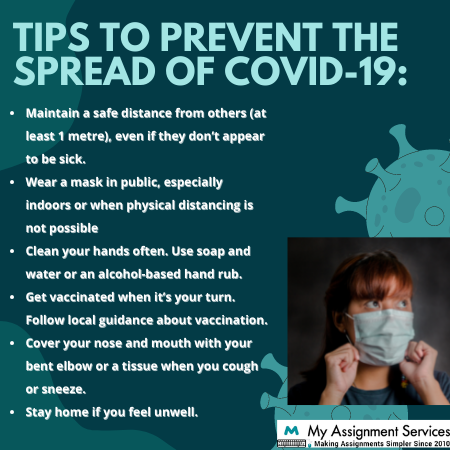
How Are Infections Transmitted Through Various Modes of Transmission?
Infectious microorganisms differ by size, survival time on surfaces or air, and transmission mode. Along with virulence variability, such factors result in treatment complications and other complex symptoms that may be treated via special healthcare procedures. The special precautions are divided into groups based on the transmission mode and the infectious agent. You must attain knowledge and understanding of such concepts before writing HLTINF001 assessment answers.
As of 1st April 2022, Australia reported 5,512,954 confirmed Covid cases and 7,002 deaths in the country due to the same. - WHO (World Health Organisation)
Direct Contact
The physical transfer of infectious microorganisms to a healthy person from an infected person through physical contact.
Indirect Contact
Such transmission is often the result of contamination of objects or the via unclean hands. The infectious microbe stays on the surface of objects that the next touches and gets infected.
Learn how to acknowledge any source of information using the APA 7th style.
Download Now
Airborne Transmission
The transfer of infectious bacteria from one person to another through air or droplet transfer. The infected person sneezes, and water droplets fall on the healthy person or remain suspended in the air, further contacting a healthy person.
Common Vehicle
The type of infection transmission that occurs due to unintentionally sharing a common object - utensil, water, clothes, medical equipment - with the infected person.
Direct or indirect contact is the most common transmission mode of infections. Gastrointestinal infections caused due to transmission of Noroviruses are a great example of such spread. Hence, hygiene is the key to controlling and preventing such infections from spreading.
HLTINF001 Comply with Infection Prevention and Control Policies and Procedures Assignment Sample
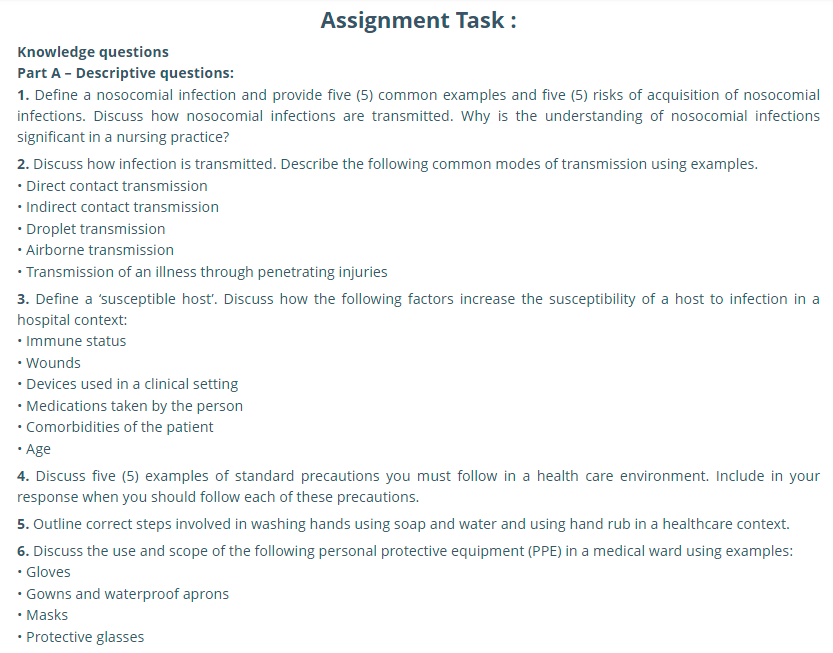
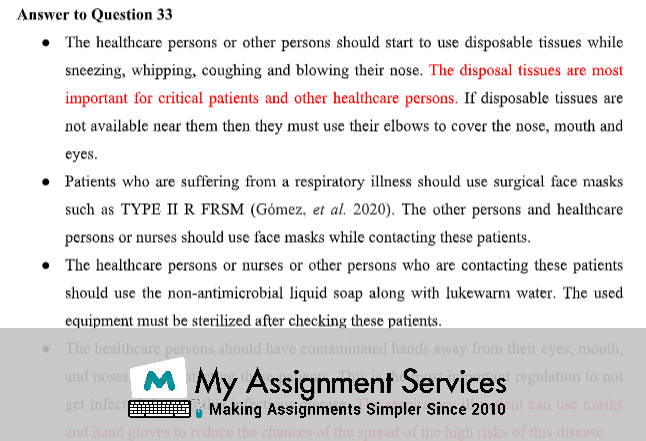
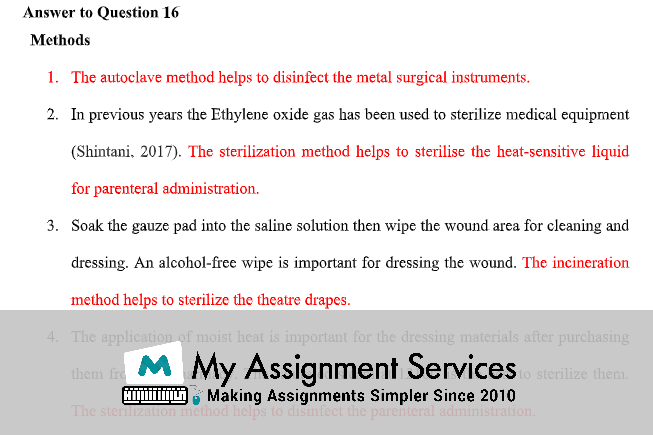
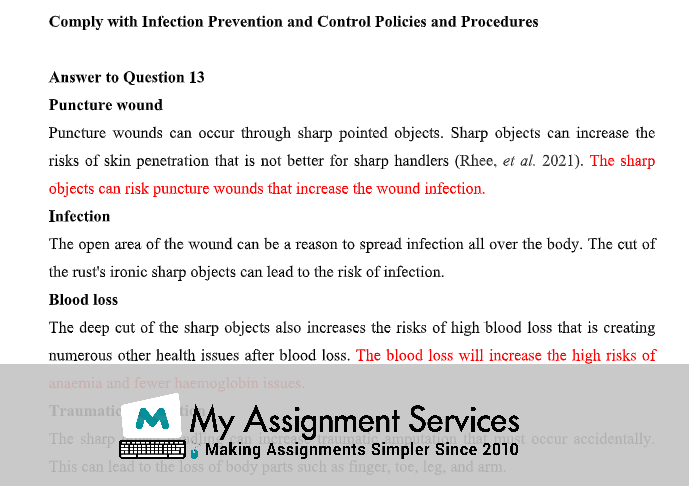
What Are the Precautions That Must Be Followed in A Healthcare Setting to Prevent and Control Infections?
Basic precautions are important for lowering the risks of transmitting such infections and pathogens from known or unknown sources. The basic level of infection transmission prevention and control measures include:
As per the reports published by the AIHW (Australian Institute of Health and Welfare) in April 2021, there were 153 confirmed Covid cases and no fatalities in the Aboriginal and Torres Strait Islander communities.
- Promoting a safe climate is the foundation of prevention and control of transmission of infections in healthcare facilities.
- Standard measures for precautions should be mandatory for all healthcare workers when treating or diagnosing patients.
- Assessing the risk for all the healthcare activities helps calculate the level of concern and aids nurses in initiating personal protection.
- Source control measures implemented for all healthcare professionals suffering from respiratory symptoms can be controlled through maintaining respiratory hygiene and etiquette for coughing and sneezing.
- Hand hygiene is another important precaution, and it's always been important, but recent circumstances have shown us its necessity.
This is an important concept you should learn while composing HLTINF001 assessment answers. The global inflation of the number of infections has escalated the use of standard prevention measures and basic hygiene protocols that will help reduce risks involved in healthcare. Institutional safety standards help improve conformity within the industry climate by implementing safety and prevention measures to lower the risk of infection spread.
Nursing is a demanding industry, and students have to work on various assignments, lab reports, case studies and reflection writing. Keeping up with the theoretical and practical knowledge is a handful and if you seek nursing assignment help, chat with one of our experts to get insight on complex concepts and live guided sessions.
Related Study Materials
Our Experts can answer your Assignment questions instantly.
Ask Question0 Comment
Get It Done! Today
1,212,718Orders
4.9/5Rating
5,063Experts













Loved reading this Blog? Share your valuable thoughts in the comment section.
Add comment